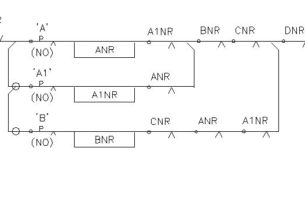Metro Rail Basic Signalling Concepts
Control over movement of Trains & Development of signals.
1. This mode has its own inherent problems.
2. Trains cannot be steered away as in the case of other transports.
3. They are required to follow one another in the same direction on track, as otherwise for every vehicle separate parallel paths are to be provided.
4. Control over movement of Trains & Development of signals.
5. Railway locomotion, therefore, though more efficient, brings in problems of “Control over movement of Trains”.
Railways Signalling adopts two methods for controlling over movement of train:
–Time interval method
–Space interval method
Time Interval Method
1. In this method, trains are dispatched in the same direction at a fixed interval of time, irrespective of the status of earlier dispatched train.
2. Where the speeds and weights are low, it is not difficult for a following train to stop short of the train ahead, which has stopped.
3. With higher speeds and heavier loads, the distance required to stop a train is longer, and at this longer distance, the driver cannot definitely decide whether a train in front has actually stopped or not.
4. This makes it difficult for the driver of the following train to run his train at desired speed.
5. If all trains run at the same speed and are required to stop at the same place for the same duration, a certain amount of control can be exercised by having a definite time lag between the trains from one stopping place to another.
But in the case of Railway, this is not practicable as –
(a) Different types of trains like, Express/Mail, passenger, high-speed freight and low speed freight shunting trains are run.
(b) The speeds of all the trains are not same.
(c) The terrain of the country is not same everywhere.
(d) The brake power, hauling capacity, load of train is not same for all trains; and
(e) The stopping places of all trains are not the same.
Hence, it is not possible to control the movement of trains under the “Time interval” method.
A better method of control the “Space Interval Method” is therefore more commonly adopted.
Space Interval Method
1. In this method of “Control over movement”, the length of track is divided into sections called “Blocks”. The entry of a train into the ‘block’ is controlled in such a way that only when it is free, a train can be allowed to enter it. This means that between two consecutive trains, there is a definite space interval.
`A’ and `B’ are two block stations. Under the Absolute Block System controlling the movements of train between `A’ and `B’ is such that, Station `A’ can allow a train to leave his station towards Station `B’ only when the line clear is obtained from Station `B’. Station `B’ is supposed to give the “line clear” for a train to approach towards `B’ only, when the whole block section is clear of trains. That is, when the previous train has cleared the block section as well as the adequate distance beyond the block section.
2. This system of controlling train movement is more commonly known as “BLOCK SYSTEM or BLOCK WORKING ”.
3. So with the two controlling points and intercommunication, it is possible to control the entry of a train into a block only when it is vacant.
Signaling in Metro Operations
1. Such constraints of railway working is observed more prominently in metro system of working as:
2. The frequency of trains (Headway) is very high.
3. Availability of lines for operations on main line are very limited (only one line for up direction and only one for down direction).
4. The crossing stations are limited and as the trains are worked in a closed loop, a delay to one train is potentially a delay to entire system.
5. Such challenges can only be met by adopting the most advance technology of railway signaling for working of trains on a metro system.




